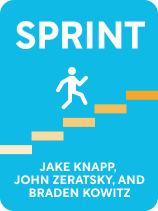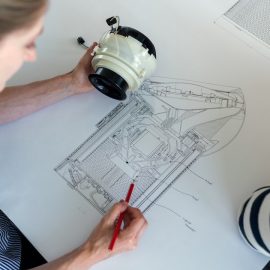

This article is an excerpt from the Shortform book guide to "Sprint" by Jake Knapp, John Zeratsky, and Braden Kowitz. Shortform has the world's best summaries and analyses of books you should be reading.
Like this article? Sign up for a free trial here.
Looking for a product design critique example? How does the sprint method inform design critique?
Jake Knapp’s Design Sprint method aims to teach product designers how to test a product idea in just five days. Using the sprint method for design critique is helpful if you’re stuck in the middle of a project that seems to be going nowhere.
Read on for a product design critique example from Knapp’s bestselling book Sprint.
Critiquing Product Design—the Sprint Method
Jake Knapp developed the Design Sprint while working at Google Ventures, the investment arm of Google’s parent company. His process allows you and your team to build and test a prototype in just a five-day work week. With the help of John Zeratsky and Brian Kowitz, Knapp ran hundreds of successful sprints at Google and other companies like Lego, Airbnb, and Slack. An important part of Knapp’s sprint method is the product design critique—an example of Knapp’s critique process is detailed below.
Group Brainstorming for Design Critique
After holding many workshops experimenting with group brainstorming methods and getting unimpressive results, Knapp found that people generate their best ideas individually. Other research supports this conclusion: When brainstorming is done in a group setting with no structure, people come up with fewer, less unique, and less practical ideas than they do when working alone.
In order to effectively collaborate to critique your product design, you need to know when to generate ideas separately and when to come back together. For example, you might choose to only work as a group when you’re ready to narrow down your individually-generated ideas into a list of the best options for the project’s purpose. Knapp, Zeratsky, and Kowitz demonstrate this by having you first work alone during the design drawing process and then instructing you to critique the designs as a team.
Example of Design Critique
In their example of critiquing product design, Knapp, Zeratsky, and Kowitz suggest you begin the critique by putting everyone’s final drawings from Tuesday in a row on the wall. These should be anonymous. Give everyone some dot stickers and review the drawings silently. When you see something you like in a design, place a dot next to it. Write any concerns you have on sticky notes and place them below the drawing.
After the review period, the authors recommend critiquing each design for three minutes. The sprint coordinator should speak first, describing the ideas that people have marked with dots. These “ideas” might be someone’s whole design, or they might be certain aspects of a design. If necessary, the team can point out any promising piece of a design that the coordinator didn’t mention.
A person who is not the coordinator will write the team’s observations on sticky notes to place above the drawing. Then, you’ll discuss the concerns and questions the team wrote about the design. Finally, the person who drew the sketch can explain anything the team missed in their drawing.
Each person gets a dot sticker to place next to the drawing they think represents the best design for your product. As with other major choices in the sprint, the team leader gets the final say in the design you choose. This might make the dot voting seem irrelevant, but the team’s votes do matter. If the team leader is struggling to choose between multiple design ideas, the team’s input may be the thing that sways their decision.
Advice for Effective Design Critiquing
During this step, you have to put your drawing up on the wall and stand by as your teammates analyze and critique your best design idea. Hopefully, by this point, Knapp, Zeratsky, and Kowitz’s structure has allowed you to build enough trust with your teammates to make this a less daunting task. However, even in the best of team environments, putting your design up for critique is a vulnerable act.
Adobe has some useful tips for what to do (and what not to do) during a product design critique to make the experience as smooth and productive as possible:
- Frame feedback in a positive-constructive-positive form, where any constructive critiques are bookended with things you like about the design. Knapp, Zeratsky, and Kowitz deviate from this structure with their critique script, which has you discuss concerns you have with a design after all the positive comments have been made.
- Make your feedback as specific as you can. Don’t just say you like a feature of a design, say why you like it. The same applies to things you don’t like. Without your reasoning, your comments are just personal opinions, which aren’t as strong of a contribution to the group’s decision-making process.
- If you have a problem with a design, offer a solution that might fix it. Designing your product is a collaborative effort, and you may have insight to offer that the creator of the drawing wouldn’t have thought of.
- Keep feedback as objective as possible. Ego and personal relationships shouldn’t factor into your criticism. Luckily, by keeping the drawings anonymous until the creator has a chance to speak, Knapp, Zeratsky, and Kowitz have removed a lot of the potential for personal bias in your sprint’s critique step.

———End of Preview———
Like what you just read? Read the rest of the world's best book summary and analysis of Jake Knapp, John Zeratsky, and Braden Kowitz's "Sprint" at Shortform.
Here's what you'll find in our full Sprint summary:
- How to build and test a prototype in just a five-day work week
- The step-by-step processes for planning and completing a sprint
- How to conduct one-on-one interviews with your customers






